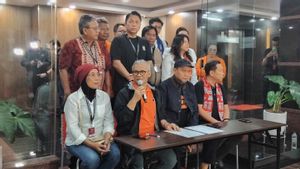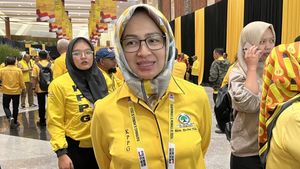JAKARTA - Forest and land fires (Karhutla) this year are still a real threat in sight. BMKG estimates, the peak of the dry season in the Sumatra region, will occur between June-August. However, hotspots in vulnerable areas have actually appeared since the beginning of the year.
This is the toughest test for efforts to control forest and land fires, because at the same time Indonesia is at war with the spread of the Covid-19 pandemic.
The potential for the Karhutla 'disaster duet' which causes the impact of the haze disaster and the Corona virus is clearly a cause for concern, because the characteristics of the impact are relatively similar to the physical effects of human victims, namely both attacking the respiratory tract.
Post Karhutla 2015, the government has actually carried out a massive policy evolution in controlling forest and land fires. This policy evolution has been translated into various actions, both at the task force organization level, the private sector, the community and other non-technical levels up to the site level.
However, because forest and land fires have a complex problem that is 'plaguing' everywhere, so often the policies that have been, are, and will be carried out in anticipation, have not been understood or even felt the benefits directly by the public.
This automatically affects public perceptions and opinion, which leads to the main question, "what are the government's efforts in controlling forest and land fires which have become a seasonal disaster? Especially during the Corona pandemic which has been declared a national disaster".

Forest fire illustration (Image by sippakorn yamkasikorn from Pixabay)
Based on Inpres 11/2015, more than 25 Ministries / Agencies, including the Regional Government, have an equal mandate in various efforts to control forest and land fires in Indonesia. The Ministry of Environment and Forestry (KLHK), is just one of the many Ministries / Agencies that are members of the Forest and Land Fire Control Task Force.
The core team of the Karhutla Task Force whose members are also assigned to the site level are the National Disaster Management Agency (BNPB), TNI, Polri, and most importantly elements of the Regional Government. Through this Presidential Instruction, the working paradigm of handling forest and land fires is no longer focused on extinguishing efforts, but controlling.
Control in question starts from the planning, prevention, countermeasures, post fire, work coordination and alert status stages. Everything is mandated to apply to all levels of the Task Force work organization, from elements of the central government to local governments.
Regarding the pandemic, President Joko Widodo issued Presidential Decree No.12 of 2020 concerning the Determination of the Non-Natural Disaster of the Corona Virus Disease 2019 (Covid-19) as a national disaster. Referring to Law number 24 of 2007, the President then appointed the Head of BNPB, Doni Monardo as the Head of the Task Force Command to accelerate the handling of Covid-19.
The President also issued Presidential Decree number 7 of 2020, as a working guideline for almost all Ministries / Agencies and Local Governments to take quick, precise, focused, integrated and synergistic steps in dealing with the spread of the virus.
The direct implications of these various policies have made the workload of the Karhutla Task Force and the Covid-19 Task Force even heavier. Moreover, in these two task force organizations (Corona and Karhutla), members come from the same various Ministries / Agencies, but with different duties and functions.
The focus of the Karhutla Task Force will immediately be divided on the handling of Covid-19. The TNI / Polri work team, which has been required to participate in efforts to control forest and land fires, is currently also dealing with Covid-19. Likewise with elements of the local government as guardians of forest and land fires at the site level, which of course must refocus programs and budgets in dealing with Corona in their respective work areas.
The movement to control forest and land fires in the field is certainly not as easy as imagined. Apart from the difficult access to forest and land fires, there are several villages that have implemented local lockdowns, so that the early movement of the Manggala Agni team and other members of the Karhutla Task Force have experienced obstacles. Not to mention the threat of the spread of the Corona virus which threatens the Task Force members who continue to work at the forefront of controlling the Karhutla.
Ministry of Environment and Forestry Policy on the COVID-19 PandemicWhen BNPB, TNI and Polri are focusing on the impact of policies on handling Corona, KLHK is of course now the leading sector in controlling forest and land fires. Forest and forest fires control measures have actually been carried out long ago, but in an unusual situation due to the Corona pandemic, the Ministry of Environment and Forestry has responded with various policies that are more adaptive and responsive.
Forest and forest fires control work at the site level, such as integrated patrols, ground check hotspots, blackouts, and environmental law enforcement activities, are still being carried out by implementing the Covid-19 protocol. Daily reports from information pockets in the regions are submitted to the data center in Manggala Jakarta.
The Minister of Environment and Forestry also followed up on the pandemic situation by issuing circulars, various instructions, and making policies through intense meetings which were held virtually. The Ministry of Environment and Forestry allocated a budget of Rp1.01 trillion to support the Social Assistance program or Government assistance to communities in and around forest areas, especially forest farmer groups and social forestry groups, as well as officers serving in the environmental and forestry sectors affected by Covid-19. . This allocation is the result of activity refocusing and budget reallocation which has received support from Commission IV DPR RI.
An innovation policy was also carried out by the Ministry of Environment and Forestry's Research, Development and Innovation Agency (BLI) by producing disinfectants from wood and bamboo vinegar (liquid smoke) and hand sanitizers with liquid smoke (wood vinegar), borneol, ethanol and glycerol formulas, to anticipate the spread of the virus. Corona Covid-19.
Guarding the effects of COVID-19 at the site level, KLHK continues to encourage the local economy through the Social Forestry program, so that farmers can still harvest during the pandemic. Forest farmers' products such as empon-empon, ginger, honey, and others are then purchased and given free of charge to medical personnel at the forefront of handling Corona.
At the technical level of law enforcement, the Ministry of Environment and Forestry won a lawsuit at the Jambi District Court in the Karhutla case against PT Agro Tumbuh Gemilang Abadi (PT ATGA) with a verdict of punishing environmental damages of Rp. 590.5 billion.
Investigators from the Directorate General of Gakkum, KLHK also continue to attend trials of illegal logging perpetrators with Video Conference facilities, and continue to drag the perpetrators of the criminal case of the Karhutla corporation PT. Kumai Sentosa (KS) went to court for the forest and land fires case in Central Kalimantan in August 2019. The area of land that burned at that time was around 2,600 ha.
Several other environmental law cases from various regions in Indonesia are also reportedly ready to be tried (P-21). This is a strong signal from Manggala, that even in the atmosphere of the Corona pandemic, the Directorate General of Gakkum KLHK is still working. Likewise with conservation activities such as rescuing and releasing animals into their habitats.
In addition, together with the Meteorology and Geophysics Agency (BMKG) and the Agency for the Assessment and Application of Technology (BPPT), the Ministry of Environment and Forestry also decided to immediately implement Weather Modification Technology (TMC) to wet peat, fill reservoirs and canals, in anticipation of the arrival of the dry season. TMC priorities were carried out in three prone provinces, Riau, Jambi and South Sumatra.
Another adaptive policy, KLHK provides training for Social Forestry assistants electronically / E-Learning. The 25-hour training was held from 27 April to 18 June 2020 in stages, followed by around 3,000 participants throughout Indonesia, divided into 100 batches, where one batch consists of 30 participants. Karhutla awareness and control was one of the materials presented to the participants.
Maintain PeatPeat is the area that is most vulnerable and also the most difficult to extinguish if it burns. In the 2015-2019 period, it was recorded that around 4.08 million ha of peat in seven restoration provinces were still reported to be burnt. This amount dominates from the 5.4 million ha of the total burned area in the same year period (Prof. Bambang Hero Sahardjo, IPB).
Although the figure for the period of 4 years is actually still relatively lower, when compared to the area burned in the 1997/1998 forest and land fires incident which reached 11 million ha, 2006 forest and land fires which reached 10 ha, or the reality that in just one year 2015 the burned area reached 2.6 million ha.
For the record, 2019 forest and land fires are burning in many countries in the world. For example in Canada (1.8 million ha), America (1.9 million ha), Amazon (2.2 million ha), Siberia (6.7 million ha), and even neighboring Australia, must feel the ferocity of fire that scorches forests. and their land is nearly 12 million ha.
Indonesia itself in 2019 experienced forest and land fires with an area of 1.6 million ha, after previously in 2016-2018 it succeeded in suppressing forest and land fires by an average of 80-90 percent of 2015 cases.
These figures show that the intervention of peat protection policies and a shift in the working paradigm from blackout to control have succeeded in bringing Indonesia to a new phase of handling forest and land fires. The work system has been shown to be fruitful, although it must be admitted that there are still weaknesses here and there.
The success of a policy, of course, is not only based on numbers alone, but on field realities. In reality, peatlands that should be protected are still experiencing fires and this is of course still the government's big homework.
The massive destruction of peat due to land use changes since decades ago, clearly presents challenges that cannot be easily resolved in just 5-10 years, let alone recover immediately.
Peat protection is clearly an obligation that involves many government and private agencies. Specifically at the Ministry of Environment and Forestry, still in the pandemic era, the Minister of Environment and Forestry has issued a Decree.851 concerning the Establishment of an Indicative Map for the Termination of New Permits for Primary Natural Forest and Peat Land in 2020 Period I. This is in the context of implementing Presidential Instruction No. 5 of 2019 concerning the Termination of Granting of New Permits and Improving Management of Primary Natural Forests and Peatlands.
Thus, it was recorded that primary natural forest and peatlands that were protected and could not be transferred for other activities increased to an area of 66.3 million ha. The area of forested land throughout Indonesia's mainland is 94.1 million ha or 50.1% of the total land area.
From the results of the evaluation of plantation permit holders (HGU), the prevention of forest and land fires through restoration of the peat ecosystem continues to be carried out by building several infrastructures such as Groundwater Levels (TP-TMAT), TMAT Manual, TP-TMAT Logger, and canal blocking.
Meanwhile, in the Industrial Plantation Forest (HTI) area, forest and land fire prevention through restoration of the peat ecosystem is carried out by building several infrastructure such as 376 Manual TMAT-Structuring Points, 106 automatic TMAT units, 7 rainfall stations, and 321 canal blocking units.
As a result, there was no forest and land fires in 2019 in peat areas that had been intervened with wetting, or in areas of restored peat. This is what must be maintained, although challenges remain, especially from the conversion of peatlands outside the area (community land).
Policy Communication in Times of CrisisConfusion usually characterizes the policy area. In that area, the language that is shared may contain many meanings that may conflict with one another. (Young, 1987: 94)
What the government has done has actually been running not on a symbolic aspect, but on a substantive basis. But usually because the language of policy with the communicative language of the government to the public is almost certain to experience ambiguous (ambiguous) or the meaning is understood more than one, sometimes even though the policy is correct, it still raises doubts, obscurity, obscurity and so on from the public.
The adaptive and responsive policies carried out by the Ministry of Environment and Forestry during the corona pandemic were to cover the forest and land fire mitigation policies. However, the real challenge remains in the reality of work in the field of all elements of the Task Force team, including the community, in responding to the threat of forest and land fires which has become a seasonal disaster.
For that reason, the decision makers related to forest and land fires, as stated in Presidential Instruction 11/2015, continue to carry out their duties and responsibilities during these difficult times. The right and fast policy response will be the key to the success of forest and land fire control.
The other most important thing is to communicate various public policies related to forest and land fires properly to the public. This requires innovation, creativity, and even harder work. As well as increasing synergy between the parties, so that there is no 'disaster duet' meeting at the same time.
Dr.Afni Zulkifli
* Lecturer at the Faculty of Administrative Sciences (FIA) Lancang Kuning University Pekanbaru-Riau * Expert from the Minister of Environment and Forestry * Originator of Generation Activator (GeRak)
VOI editors receive opinions, ideas and analyzes from readers about an event. The content of the writing is outside the responsibility of the editorial staff and is entirely in the hands of the author. The writing is not a description of the editor's attitude. Please send your work to [email protected].
The English, Chinese, Japanese, Arabic, and French versions are automatically generated by the AI. So there may still be inaccuracies in translating, please always see Indonesian as our main language. (system supported by DigitalSiber.id)












